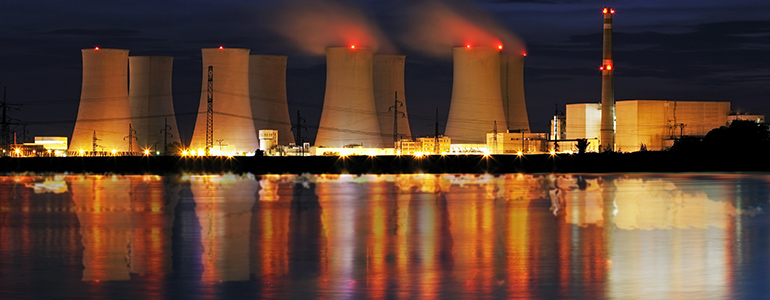Fitness-for-Service

15 Jan 2019
Nuclear Plant Piping
As nuclear power plants continue to age, safety-related piping could be subject to one or more degradation mechanisms where fitness-for-service evaluations may become necessary. The damage resulting from these mechanisms can be categorized broadly into 2 categories – cracking or wall thinning. Cracking (planar geometry, defined in 2 dimensions) can result from fatigue damage (e.g., vibration or thermal cycling) or stress corrosion cracking. Wall thinning (nonplanar geometry, defined in 3 dimensions) includes flow accelerated corrosion, pitting, erosion or general corrosion that results in localized or wide-spread wall loss. The causes behind these degradation mechanisms can include poor water chemistry, beyond design basis loading, adverse operating conditions and many others.

Through-wall leak in service water piping
All nuclear power plants in the U.S. follow the rules given in ASME Boiler and Pressure Vessel Code Section XI for their in-service inspection activities. During these inspections, degradation may be discovered where the measured pipe wall thickness is less than the design minimum wall thickness. Note that the design minimum wall thickness is typically used as a first level screening threshold and normally adjusted to account for future wear over the next inspection interval. When a measured wall thickness is found to fall below the design minimum wall thickness, plant action is necessary to disposition the finding. Plant action is also necessary when through-wall leakage is identified at any time.
Repair or replacement is an available option; however, deferment is typically preferred for economic reasons provided a technical basis shows no negative impact to system function and structural integrity is demonstrated using methods approved by the Nuclear Regulatory Commission (NRC) assuring plant safety. Thus, in many instances an analytical evaluation is employed to show acceptability of the degraded piping until a specified future date (or until the end of service life if the degradation is mitigated).
Understanding what methods are approved by the NRC for flaw evaluation can be challenging and difficult to quickly navigate when an emergent nonconformance is identified. The Code of Federal Regulations, 10CFR50.55a, lists the codes and standards approved for incorporation by reference with any applicable conditions imposed by the NRC. Therein, one can find the latest approved revision of Regulatory Guide 1.147 which provides a list of approved, with or without conditions, ASME Section XI Code Cases. Code Cases supplement the guidance given in ASME Section XI addressing specific issues that plants may encounter during operation. Another useful resource is the NRC Inspection Manual, Chapter 0326, which gives NRC inspectors guidance to assist in their review of licensee evaluations to address operability and resolution of degraded or nonconforming conditions in structures, systems and components. Nonapproved methods may be employed by following a Relief Request process with the NRC.
When a nonconformance is identified it is typically referred to as an indication. For cracking, the acceptance standards in ASME Section XI are used to determine acceptability. Indications found unacceptable are called flaws and require further evaluation. For wall thinning, there are no acceptance standards in ASME Section XI; thus, nonplanar thinning is defined as a flaw. Note that if a flawed pipe can be shown to meet the Construction Code design stress limits (including any future wear over the inspection interval), it is deemed acceptable provided there is no through-wall leakage.
ASME Section XI provides guidance to perform flaw evaluations and show acceptance. This guidance varies depending on the flaw geometry, Code Class of the piping and operating conditions. For cracking less than 75% through-wall, ASME Section XI Appendix C can be used to show acceptance. For wall thinning, Code Case N-597 can be used to show acceptance (with regulatory approval). For through-wall leakage in moderate energy piping, Code Case N-513 may be employed for both cracking and wall thinning. Flaws found not acceptable are called defects requiring immediate repair or replacement.
Intertek is a recognized industry leader in ASME Section XI consultation and flaw evaluation in nuclear plant piping. Intertek also offers ASME Section XI training on flaw evaluation and repair options tailored to meet the specific needs of our clients. Please email robert.mcgill@intertek.com to learn more.